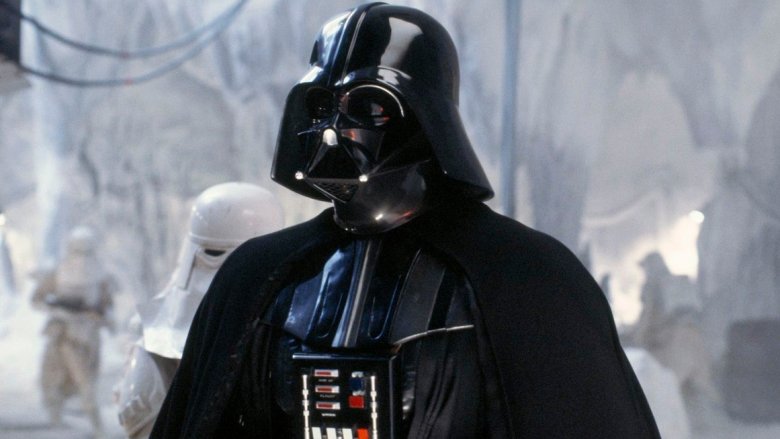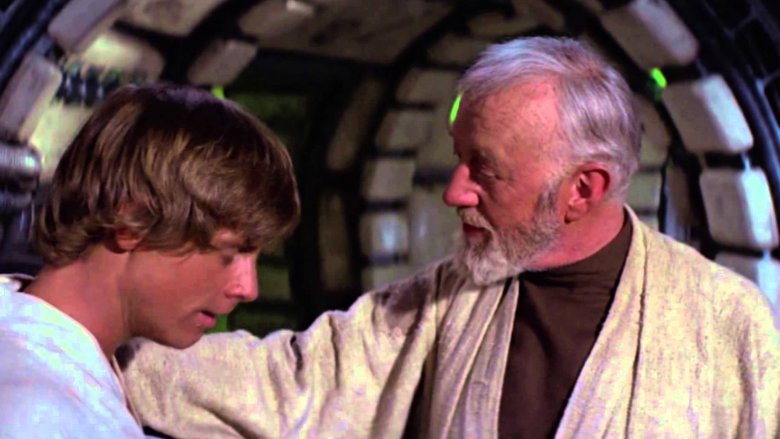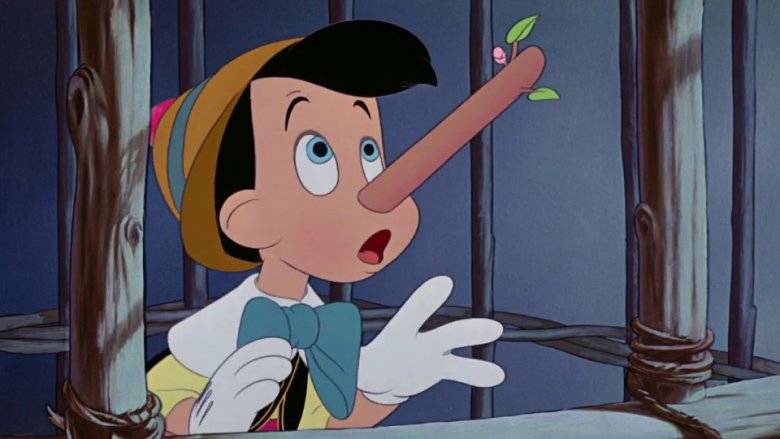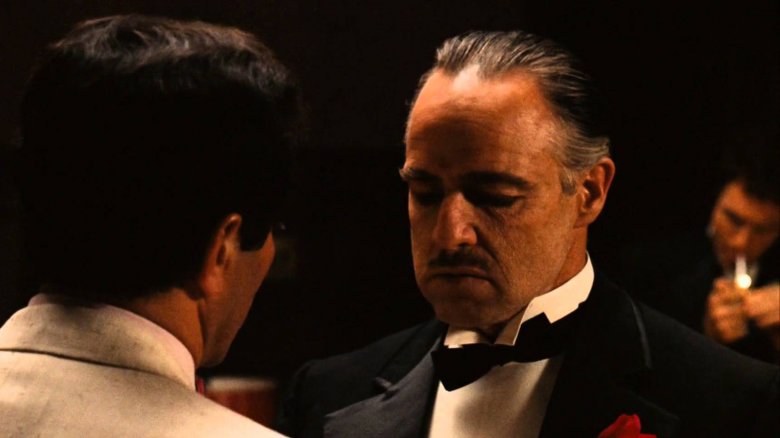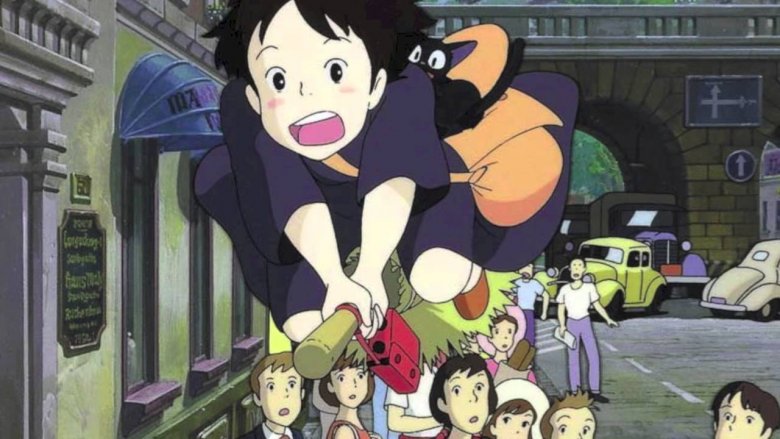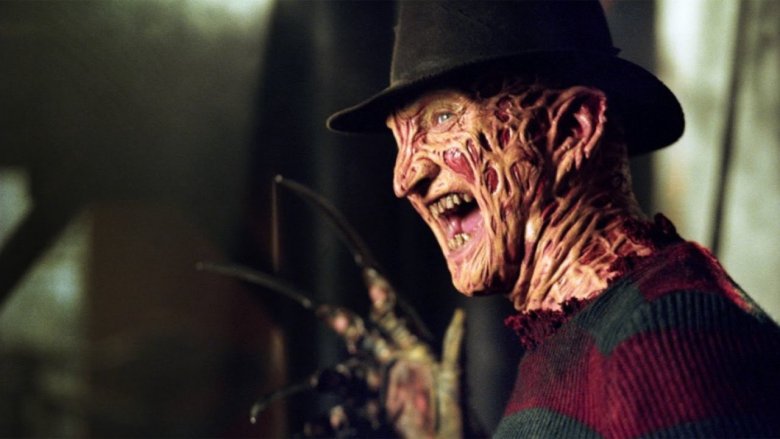Movies That Were Better On VHS
The memory of your first VHS is likely up there with your first kiss, your first car, or the first time you drunkenly went cow-tipping: a treasured memory to hold close to your heart forever. Remember holding that heavy, plastic box in your trembling hands? Remember the garish cover artwork that seemed so evocative to your tiny mind? Those were the days, huh?
Well, maybe not quite. DVD and Blu-ray still provide exponentially better picture and sound quality than VHS, after all. But you know what? Not everything is about the technical aspects. For whatever reason, there are a handful of movies out there that never achieved the same perfection on other formats as they did on humble videotape. Want to watch the following at their absolute best? Grab that old VHS player out the basement, head over to eBay, and prepare for the nostalgic thrill ride of a lifetime.
Star Wars (1977)
The original Star Wars is both one of cinema's all-time greatest masterpieces, and also one of its greatest travesties, depending on whether you're watching the theatrical version, or the extended slow-motion footage of George Lucas repeatedly kicking fandom in the nuts, otherwise known as the Special Edition. Released in 1997, the Special Edition is the New Coke of the cinematic world, without the excuse that it was the '80s and everyone involved was probably on a very different kind of "coke." It's also the only version available. If you wanna watch Han shooting first, you better hand Harrison Ford a gun and tell him what you really thought of Indy 4.
Unless, that is, you happen to have a VHS copy of Star Wars lying around. In that case, you're laughing all the way to the nerd bank.
As Starwars.com notes, the first VHS releases of all Star Wars movies predated the Special Editions by over 10 years (A New Hope by an even greater margin). While even the first VHS is subtly different than the theatrical version of Star Wars (via Inverse), it's at least in the same ballpark, as are two other versions released on VHS. It's only when it comes to the original trilogy's final video release that the ugly specter of the Special Editions rears its Bantha-like head. By contrast, Den of Geek reports that the theatrical version saw one, extremely brief, release on DVD, and then only with shoddy picture quality.
Pinocchio (1940)
Disney is proud of the restoration work it's done for modern releases, as this featurette on the restoration of Sleeping Beauty shows. For most of us, these versions are probably even better than the original. But not if you're a purist. Nu-uh. For people really into either animation or Disney, these later DVD and Blu-ray versions are less a treat for their eyes, and more like experiencing their favorite rodent spitting in their eyes while laughing at their helplessness.
The issue arises from the way the old frames are restored. As explained on the Colorful Animations blog, Disney digitally separates the characters from the background "cells" for cleaning. This has the advantage of removing the grain, but can also make the characters look flat and the background static. While there's no chance your 5-year-old daughter will pick up on this and demand a refund, it can really get up the nose of the super-fan. And Disney has more superfans than Disney himself had dodgy racist views (according to his own family!).
Which brings us to Pinocchio. According to chatter on the non-Disney but still purist site Original Trilogy, Pinocchio is a film that was left looking unnaturally flat by its restoration, with lighting that doesn't suit the original animators' intentions. Their acceptable version runs to just two releases: the 1987 CAV laserdisc and the 1984 VHS. It's never too early to get the kids into the joys of properly formatted home entertainment.
The Godfather & The Godfather II (1972 & 1974)
For most cinephiles, the first glimpse they got of The Godfather was the spellbinding scene of Don Corleone quietly listening as a man begs him to avenge his daughter's assault. But for those who sought out the first two films in their combined VHS boxset, things were very different. They started with the sight of Oreste Baldini as a snot-nosed boy freshly arrived in the land of the free, wide-eyed and innocent, unaware that he would soon grow up to become the Don of a sprawling crime family.
That's two very different openings, and it's the result of a very odd experiment NBC indulged in back in 1977. With it becoming increasingly clear that only future versions of themselves would ever get to see the jaw-dropping masterpiece that would undoubtedly be Godfather III, executives cut parts one and two into chronological order (via AV Club) and released them as a miniseries. The story started with the flashbacks of Robert DeNiro in Part II, before playing out the whole of Part I, then returning to Part II for the 1950s-set story of Michael's downfall.The result was The Godfather Epic, and you can't own it in any format but VHS.
Whether you prefer this version probably depends on which you saw first. Still, there's no denying it's an impressive way of experiencing the films, allowing you to feel time flow alongside the characters. It's been in such high demand that HBO showed the whole Epic in 2017.
Warriors of the Wind (1984)
That distant, roaring sound you hear is every anime and Studio Ghibli fan on Earth converging on Grunge headquarters with pitchforks and flaming torches. Warriors of the Wind is a travesty. The U.S. recut and dub of Hayao Miyazaki's spectacular environmental fable Nausicaa of the Valley of the Wind, it trashes the great animator's vision, turns a complex film into a kid-friendly cheese-fest, and inexplicably relegates its female lead to background status on its VHS cover, behind some male characters who aren't even in the movie (via Cinematheque). It's a desecration of the original ... and, if you saw it on VHS as a kid, probably one of your favorite movie experiences ever.
It's worth remembering the '80s were a very different time. Everyone had enormous hairdos and shoulder pads, and anime was seen as something watched only by kids and by grown men who should never be around kids. When Roger Corman's New World Pictures bought the rights to Nausicaa, a thoughtful anime sci-fi about our impact on the planet was the hardest of hard sells to middle America. So the shlock maestro didn't even try. He just cut it into something he knew kids would pay to see. To his credit, they did.
Nausicaa is undoubtedly the better movie. But, as Anime Bargain Bin Reviews once pointed out, Warriors is nowhere near as bad as its reputation suggests. If you don't mind focusing on action and adventure over narrative coherence, it's even kinda awesome.
The Mask (1994)
Who remembers Space Ghost Coast to Coast? If you spent any time between 1994 and 2008 huffing from your bong and getting dug into snarky shows on Cartoon Network, you probably have fond — if hazy — memories. An animated talk show hosted by washed up superhero Space Ghost and two begrudging supervillains, it combined live-action celebrity interviews with the exact sort of weirdness you'd expect from a show featuring an evil preying mantis as its bandleader.
Space Ghost was a cult hit, and there are fans out there who can still quote from every episode. But there was one episode that you couldn't get in the pre-streaming internet days, no matter how hard you tried. The one that only existed on the VHS tape of The Mask.
These were the pre-special features days, before DVD first got us hooked on bonuses, then acted like the jerkiest pusher by dropping them all and forcing us to shell out extra for the Ultra Blu-ray to get our fix. This made all VHS bonuses something to treasure, especially when they involved Jim Carrey being interviewed by a space-based superhero. (This fan blog will give you an idea of just how awesome this was.)
Strangely, no DVD or Blu-ray releases of The Mask ever carried the bonus Space Ghost episode, making the VHS a collectors' item for fans of both movie and series. On the other hand, you could just watch the YouTube video above and save yourself the hassle.
Kiki's Delivery Service (1989)
The story of a young witch finding her way in the world, Kiki's Delivery Service was one of the first films by anime maestro Hayao Miyazaki to be released in the US (per Tor.com). Revoiced for an American audience by Disney in 1998, Kiki's featured a young Kirsten Dunst and a much-less young Debbie Reynolds. But the star attraction was Phil Hartman. Voicing a sarcastic talking cat, Jiji, it was the last film the Simpsons star would work on before his shocking murder. (Salon has the whole, chilling story.)
Hartman's death shook the Disney team, which dedicated the VHS release of Kiki's to his memory. Unfortunately, Hartman's performance took some creative liberties. The Japanese Jiji has fewer lines, is less sarcastic, and is female. Hartman's Robin-Williams-in-Aladdin approach to the script worked fine when Miyazaki was unknown in the U.S., but when he was an Oscar-winning household name, defecating all over his vision seemed less acceptable. Hence Disney revisiting the dub for the international DVD in 2010, which they recut to fit closer with the original. Unfortunately, this meant nearly chopping out Hartman's entire performance.
For those who first saw Kiki's on VHS or the 2003 DVD release (which didn't reach all international markets), the current DVD/Blu-ray releases can feel like losing an old friend all over again. As fan blog after fan blog will tell you, the best version of Kiki's is whatever version has the most Hartman.
Top Gun (1986)
Still the only softcore gay adult film to have won an Academy Award, Top Gun remains the absolute pinnacle of manly movies about two heterosexual guys who subconsciously wanna jump each other's bone(r)s. Brash, camp, explosive, and more '80s than a weekend spent huffing cocaine off Val Kilmer's shoulder pads, Top Gun is the ultimate boy's fantasy. Know what could make this pre-teen dream even dreamier? Starting the flick with a Pepsi ad as overblown as the contents of Maverick's pants.
The VHS of Top Gun kicked off with a commercial that both parodied the film and somehow managed to be more Top Gun than Top Gun itself. Featuring a bunch of masculine bros in fighter jets teasing one another about their inability to drink Pepsi in midair, it culminated in one genius barrel-rolling his plane to cause all that sweet nectar to flow into a strategically placed glass, before flying upside-down inches above his wingman's plane and practically high-fiving him while traveling at twice the speed of sound. It's not yet been definitively proven that this one commercial was the inspiration for Hot Shots! but the facts probably speak for themselves.
As Blogs from Geekdom has noted, this inspired Pepsi ad has never appeared on DVD or Blu-ray issues of the film. It was, and remains, a purely VHS phenomenon. If you want the full '80s experience a film like Top Gun clearly requires, it's video all the way.
A Nightmare on Elm Street (1984)
"Don't judge a video by its cover" is a phrase that absolutely should never be allowed to enter the English language. One of the best things that ever happened to bored kids in the '80s was the advent of lurid, over the top, utterly grotesque VHS cover designs. Io9 has rounded up some of the best, but there were so many you could spend several lifetimes scrolling through endless web pages documenting them and only infrequently get bored.
These covers were designed to shock, surprise, or catch eyes in an extremely crowded rental market. By the time DVD rolled around, audiences were already savvy enough that this wasn't a major requirement. While some of the old trashy covers made it onto the new format, plenty more either got lost along the way or only appeared on limited releases. One of the best among these discarded classics was the Freddy-free, deeply disturbing image for the video release of A Nightmare on Elm Street.
The Elm Street cover is an exercise in creepiness. A clawed hand drips blood over the staring face of a girl who could either be possessed, in shock, or already dead. It's the sort of image that burns itself into your mind, the sort of image you'd see in your local video store (a sort of bookstore for videos, which itself was a kind of Amazon without the internet) and have nightmares about. Now compare the modern, post-VHS era design. No contest, right?
Batman (1989)
The best Batman film to feature the second-best Batman (Bale or Batfleck for number one? Fight!), Tim Burton's 1989 version made so much money that you could found a viable new nation-state off Jack Nicholson's paycheck alone. So perhaps it's no surprise everyone seemed to be gunning for advertising space on the VHS. The result was a Batman video that not only began with a lurid Diet Coke commercial, but also with a surreal promo spot that featured Daffy Duck and Bugs turning the screws on your wallet like a couple of animated used car salesmen.
Together, the two commercials represent the peak of VHS distributors creatively trying to bleed as much money out of you as possible. The Daffy and Bugs promo spot is basically a hard sell for a Warner Bros. baseball cap that you can only get by buying a Warner Bros. catalog, which in turn you can only get by calling a premium-rate number. The Diet Coke commercial, on the other hand, is a sincere attempt to make a can look cool by sticking a cape on it and splicing in shots of Michael Keaton letting rip on his Batmobile.
The whole package is tacky as heck and has no bearing on the movie itself. But you know what? For those old enough to remember it, watching these cruddy commercials was as much a part of the Batman viewing experience as foreplay is to horizontal hugging (albeit hopefully with less Daffy Duck).
Frankenhooker (1990)
"Better" is a comparative term. Watching low-budget sleaze fest Frankenhooker on any format can't be considered a positive experience, but if you have to subject your optic nerves to a movie about a man building a hooker wife out of body parts, it's certainly worth going the extra mile and getting the VHS. The movie itself still features prostitutes getting addicted to a form of crack that makes their bodies explode, but at least the box has one redeeming feature unavailable on any other format. Press a button and the box will start talking to you just like Frankenhooker herself!
VHS distributors were absolute geniuses at creating marketing gimmicks that could take an unmemorable film like Frankenhooker and turn it into fodder for respectable list-based websites a quarter-century later. Blumhouse has a list of some of the best, and they involved everything from encasing the box in a squid-y liquid pack filled with "blood" to making the crazed eyes of characters on the front light up and flash. When was the last time you bought a Blu-ray inside a fake blood pack? That sentence, right there, is why VHS still has fans.
The best of these gimmicks may have been the Frankenhooker box. With the push of a button, you could make the video whisper the movie's tagline ("Wanna date?") in an eerie female voice. Shame there wasn't a second button you could push that would swap the movie inside for one you actually wanted to watch.
